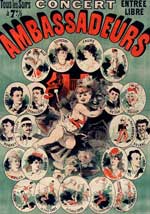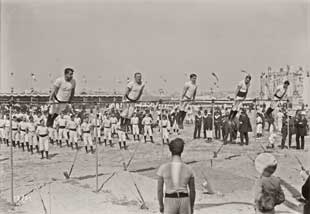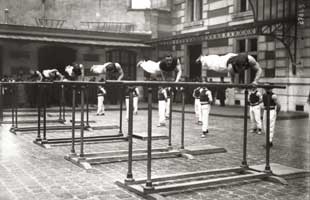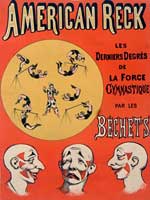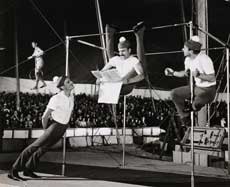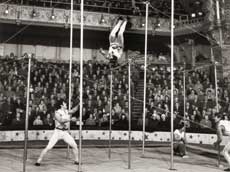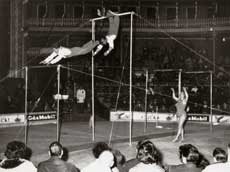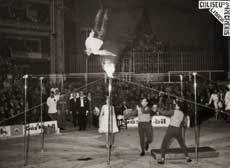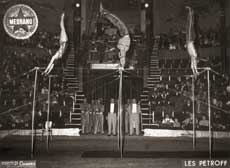by Pascal Jacob
The circus has always welcomed the integration of external elements into its core activities, particularly for a number of gymnasium apparatus. Horizontal bars are a good example of this, revisited since the 19th century by many troupes whose members often had a career as gymnasts before putting on a costume and performing in the ring. It is a device with Rabelaisian origins according to Georges Strehly, acrobatic specialist and movement theoretician. Originally, a single bar allowed a single gymnast to demonstrate his strength, flexibility and agility, in particular by performing "spinners" of legs or feet and hands, before reaching the final stage of the "great sun".
In the passage from one bar to another, there is both an idea of flight and progression, but also, paradoxically, a principle of restriction due to the very structure of the apparatus. The space is strictly delimited by a very simple geometric apparatus which is presented in a square, but whose elements can be juxtaposed to increase the possibilities of evolution of gymnasts or acrobats. First, the horizontal bar acts were the prerogative of duos or trios such as Leach and Foster or the Berli trio in 1864, but also of Hébert, a gymnast who worked alone on the Cirque Napoléon ring two years later.
The ritual remains the same for everyone. The acrobat carefully straps his wrists, puts on his grips, sprinkles them with white powder and jumps towards the bar with a slight leap. Grips are leather protections to prevent hand injuries. They are attached to the wrist, extend in the palm and end in holes through which the fingers pass. The practice gradually evolves, driven by the innovations of acrobats who constantly compete to increase the level of difficulty of the exercises. Lauck and Fox are the creators of the triple-bar work. They thus broaden the technical range of the discipline and offer new possibilities for jumps and transitions, creating at the same time a device that is multiplied in number and height. The Poppescu, Gustinos, Egelton, Hegelmann, Banolas, at the beginning of the 20th century, or the Loretta Twins introduced on one of the three rings of the American giant Barnum & Bailey in 1910, helped to popularise a very acrobatic technique and quickly give it a circus-like identity.
Exoticism sometimes brings a certain colour to the performances, just like the Petroffs, three men and a woman, who perform in Indian clothing. Other troupes such as the Hanlon Volta around 1873, the Dare brothers from 1880 and the Ducane brothers at the Cirque d'Hiver in October 1898 or the Durwal brothers, who performed acrobatics with five horizontal bars on the Alphonse Rancy circus ring in 1910, are evidence that the feat continued from one century to the next. In the 1920s, Averino played Une leçon de gymnastique in Joinville as a parodic gymnastics lesson while the duo of bar acrobats Miller and Canning took on the role of Mr. Pickwick and Mr. Micawber, who were Charles Dickens characters transformed by an acrobatic series of beautiful circus routines. In line with changing times and fashions, like others such as Victor Fratellini or Josep Andreu Rivel, have chosen Charlie Chaplin's silhouette for a trapeze act, the bar acrobat Oliveras becomes Groucho Marx for a very unusual acrobatic sequence.
The beginning of the 20th century also saw the advent of aerial bars, an evolution that would open a new chapter in the discipline and lead to a new approach to acrobatics. This is the case for Le Carillon, created by Valentin Gneushev in the early 1990s with the bar acrobats of the Peresvony troupe, a magnificent aerial ballet based on an original composition by Valeri Gavriline. This act shakes up the conventions of the genre and will inspire several creations over the following decades.
The impressive skeleton of the Bateau (French for "boat"), which oscillates above the gigantic basin of the show Ô in Las Vegas and gives the necessary impetus to the acrobats, Tournik, an aerial bar system designed for Corteo or the evolutions inscribed in the sinuosity of the giant turtle shell created for Totem, three Cirque du Soleil shows directed respectively by Franco Dragone, Daniele Finzi Pasca and Robert Lepage, are all creative extensions of a unique technique. If the Rectons, gymnasts from the powerful East Berlin school, embodied the discipline in the 1970s, notably at the Hippodrome de Pantin, at the circus of Jean Richard's GDR in 1978, twenty years later the Rokashkovs, directed by the Russian creator Alexander Grimaïlo, succeeded in synthesising in a few minutes the ideal alliance of technical virtuosity and poetry on the same system of bars arranged to form a square. Horizontal bars have definitely become a circus apparatus.



